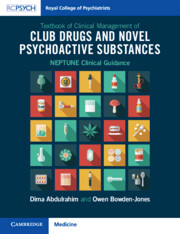 Textbook of Clinical Management of Club Drugs and Novel Psychoactive Substances
Textbook of Clinical Management of Club Drugs and Novel Psychoactive Substances Book contents
- Textbook of Clinical Management of Club Drugs and Novel Psychoactive Substances
- Textbook of Clinical Management of Club Drugs and Novel Psychoactive Substances
- Copyright page
- Contents
- Acknowledgements
- Part I Introduction and Background
- Part II Drugs with Primarily Depressant Effects
- Part III Drugs with Primarily Stimulant Effects
- Chapter 8A Introduction to Stimulant Club Drugs and Novel Psychoactive Substances
- Chapter 8B Amphetamine-type Stimulants: An Overview
- Chapter 9 ‘Ecstasy’: MDMA (3,4-Methylenedioxy-N-Methylamphetamine), MDMA Analogues and Drugs with Similar Effects
- Chapter 10 Methamphetamine
- Chapter 11 Synthetic Cathinones
- Part IV Drugs with Primarily Hallucinogenic Effects
- Part V Synthetic Cannabinoid Receptor Agonists
- Part VI Concluding Remarks
- Index
- References
Chapter 9 - ‘Ecstasy’: MDMA (3,4-Methylenedioxy-N-Methylamphetamine), MDMA Analogues and Drugs with Similar Effects
from Part III - Drugs with Primarily Stimulant Effects
Published online by Cambridge University Press: 06 October 2022
- Textbook of Clinical Management of Club Drugs and Novel Psychoactive Substances
- Textbook of Clinical Management of Club Drugs and Novel Psychoactive Substances
- Copyright page
- Contents
- Acknowledgements
- Part I Introduction and Background
- Part II Drugs with Primarily Depressant Effects
- Part III Drugs with Primarily Stimulant Effects
- Chapter 8A Introduction to Stimulant Club Drugs and Novel Psychoactive Substances
- Chapter 8B Amphetamine-type Stimulants: An Overview
- Chapter 9 ‘Ecstasy’: MDMA (3,4-Methylenedioxy-N-Methylamphetamine), MDMA Analogues and Drugs with Similar Effects
- Chapter 10 Methamphetamine
- Chapter 11 Synthetic Cathinones
- Part IV Drugs with Primarily Hallucinogenic Effects
- Part V Synthetic Cannabinoid Receptor Agonists
- Part VI Concluding Remarks
- Index
- References
Summary
MDMA (3,4-methylenedioxy-N-methylamphetamine) has been popular among recreational drug users for a number of decades. This chapter also addresses issues pertaining to the consumption of MDMA analogues and other novel psychoactive substances (NPS) with MDMA-like effects (see ).
- Type
- Chapter
- Information
- Textbook of Clinical Management of Club Drugs and Novel Psychoactive SubstancesNEPTUNE Clinical Guidance, pp. 165 - 201Publisher: Cambridge University PressPrint publication year: 2022


